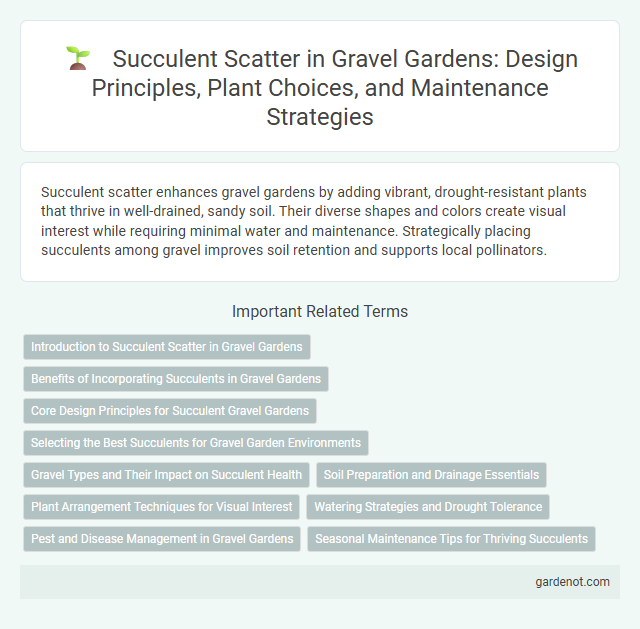Succulent scatter enhances gravel gardens by adding vibrant, drought-resistant plants that thrive in well-drained, sandy soil. Their diverse shapes and colors create visual interest while requiring minimal water and maintenance. Strategically placing succulents among gravel improves soil retention and supports local pollinators.
Introduction to Succulent Scatter in Gravel Gardens
Succulent scatter in gravel gardens creates a visually striking design by strategically placing drought-tolerant plants across rocky landscapes. These hardy succulents thrive in well-draining gravel beds, reducing water needs and enhancing soil stability. Emphasizing low maintenance, succulent scatter showcases diverse textures and colors, transforming gravel gardens into sustainable, vibrant ecosystems.
Benefits of Incorporating Succulents in Gravel Gardens
Succulents thrive in gravel gardens due to their drought-resistant properties and low water requirements, making them ideal for sustainable landscaping. Their fleshy leaves store water efficiently, reducing irrigation needs while adding diverse textures and vibrant colors to the gravel bed. Incorporating succulents enhances soil drainage and minimizes weed growth, contributing to a low-maintenance, eco-friendly garden design.
Core Design Principles for Succulent Gravel Gardens
Succulent scatter in gravel gardens emphasizes core design principles such as drainage optimization, texture contrast, and strategic spacing to enhance plant health and visual appeal. Prioritizing well-draining soil and incorporating diverse succulent varieties with varying shapes and colors creates a balanced, low-maintenance landscape. This design approach maximizes water efficiency and highlights the natural beauty of succulents against the neutral tones of gravel.
Selecting the Best Succulents for Gravel Garden Environments
Choose drought-tolerant succulents like Sedum, Sempervivum, and Echeveria for gravel garden environments due to their low water requirements and resilience to poor soil conditions. Opt for varieties with compact growth habits and vibrant foliage colors to enhance the aesthetic appeal while minimizing maintenance. Incorporate succulents that thrive in full sun and well-drained soil to ensure optimal health and longevity in gravel garden settings.
Gravel Types and Their Impact on Succulent Health
Choosing the right gravel type is crucial for succulent scatter as it directly impacts soil drainage and root aeration, essential for succulent health. Coarse gravel, such as pea gravel or crushed granite, enhances water flow and prevents root rot by reducing moisture retention around roots. Fine gravel or sand can compact easily, potentially causing poor drainage and stressing succulents, making medium to coarse gravel the optimal choice for vibrant growth and disease prevention.
Soil Preparation and Drainage Essentials
Succulent scatter thrives in well-draining soil that prevents water retention and root rot, making soil preparation crucial for a gravel garden. Incorporating coarse sand or grit into sandy or loamy soil enhances drainage and mimics succulents' natural arid environment. Raised beds or mounded soil can further improve water runoff, ensuring optimal conditions for succulent scatter growth.
Plant Arrangement Techniques for Visual Interest
Succulent scatter in gravel gardens enhances visual interest by strategically placing clusters of varying sizes and colors to create depth and contrast. Utilizing techniques such as focal points, repetitive patterns, and spacing ensures an organic yet deliberate arrangement that highlights each plant's unique texture and form. Integrating low-growing succulents with taller varieties promotes dimension, guiding the viewer's eye across the landscape naturally.
Watering Strategies and Drought Tolerance
Succulent scatter in gravel gardens thrives with minimal watering, relying on deep, infrequent irrigation to promote strong root systems. These drought-tolerant plants store water in their fleshy leaves, enabling them to survive extended dry periods without stress. Implementing mulch and ensuring well-draining soil further optimizes moisture retention and prevents root rot.
Pest and Disease Management in Gravel Gardens
Succulent scatter in gravel gardens requires vigilant pest and disease management to prevent infestations of aphids, mealybugs, and spider mites, which thrive in dry, well-drained conditions. Regular inspection and immediate removal of affected leaves minimize the spread of fungal infections like powdery mildew and root rot caused by excess moisture. Employing natural predators such as ladybugs and using neem oil sprays enhance plant health while maintaining the gravel garden's ecosystem balance.
Seasonal Maintenance Tips for Thriving Succulents
Succulent scatter in gravel gardens requires precise seasonal maintenance to prevent overwatering and root rot, particularly during wet months. Pruning dead or decaying leaves enhances air circulation and reduces pest infestations, while applying a balanced, slow-release fertilizer in spring supports vigorous growth. Regularly inspecting soil drainage and adjusting watering frequency ensures succulents adapt to temperature fluctuations and seasonal changes effectively.
Succulent scatter Infographic

 gardenot.com
gardenot.com